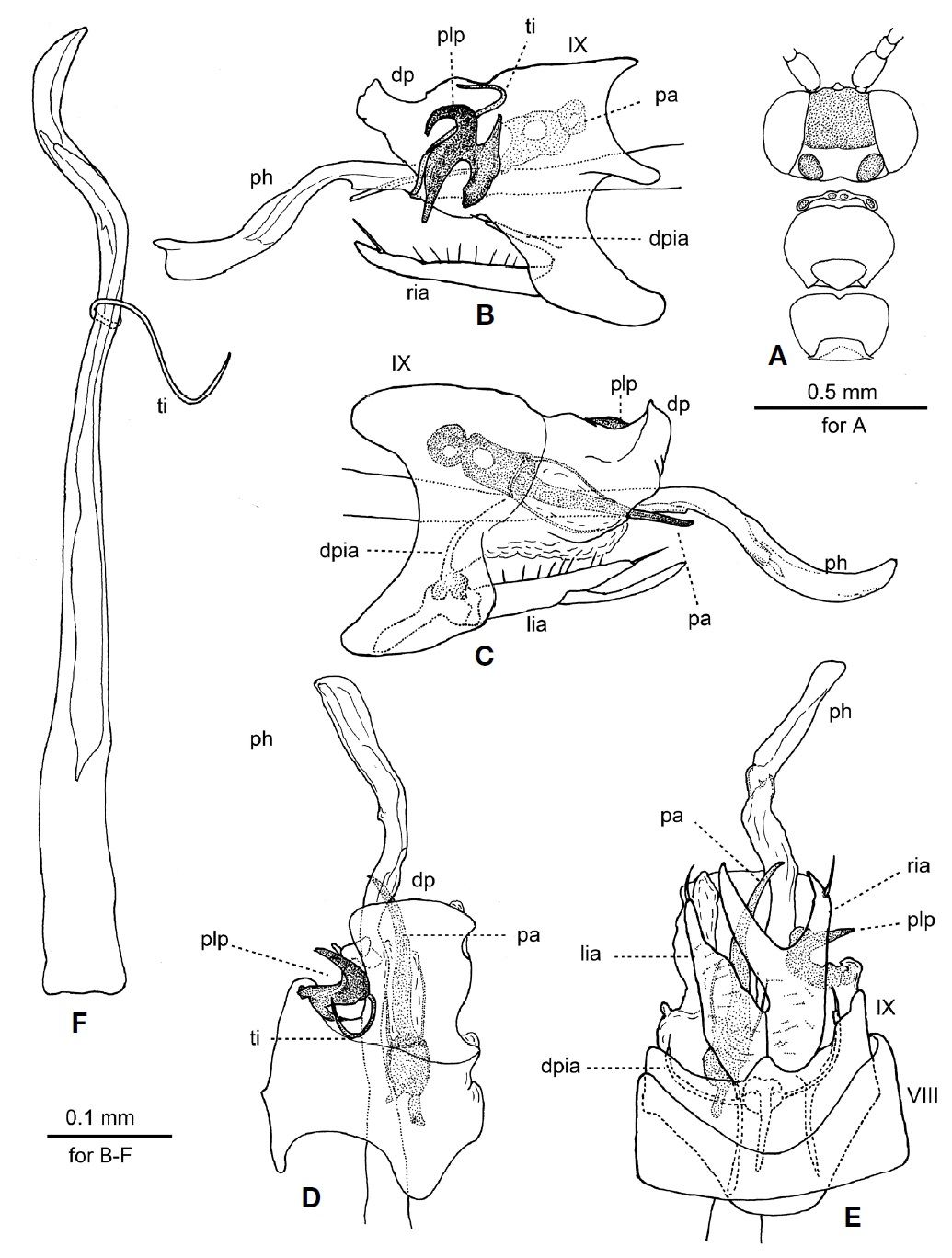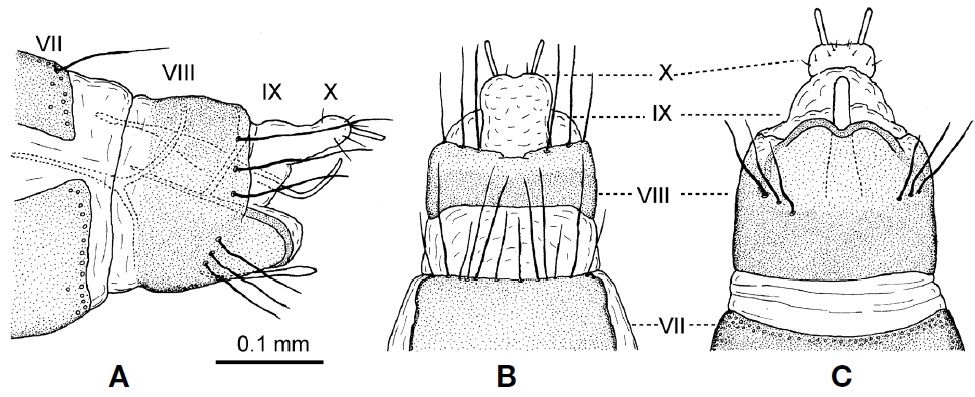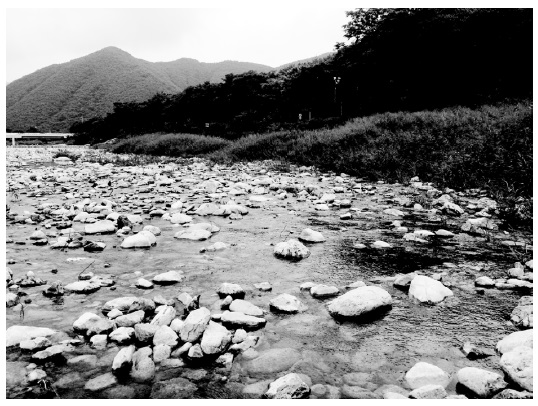



In the family Hydroptilidae Stephens, Trichoptera, 11 species in 3 genera,
Male and female genitalia were figured after treatment in dilute KOH. Morphological terms follow Wells (1979) and Marshall (1979). Type series of the new species are deposited in the collection of the National Institute of Biological Resources (NIBR, Korea). All specimens are preserved in 80% alcohol.
>
Material examined. Holotype, ♂, Korea: Gyeongsangbuk-do, Cheongdo-gun, Unmun-myeon, Sinwon-ri (35°40′42.6″ N, 128°57′29.0″E), 30 Aug 2015, Inaba S, Park SJ, light pan trap. Paratypes, 1♂2♀, Korea: same data as holotype; 2♀, Korea: Gyeongsangbuk-do, Cheongdo-gun, Unmun-myeon, Ojin-ri, Ojin-1 bridge (35°40′13.9″N, 128°58′19.3″E), 30 Aug 2015, Inaba S, Park SJ, light trap.
Diagnosis. The male of this species is similar to that of
Description. Adult: Head (Fig. 1A): having typical generic features as follows: postoccipital lobes prominent, subspherical but not modified as scent organ; ocelli absent. Thorax (Fig. 1A): having typical generic features as follows: pronotum with 2 pairs of small round warts, meso- and metascutum without any setal warts, mesoscutellum triangular and metascutellum rectangular. Spur formula 0, 3, 4. Ventral process of sternite VI small and mesal process of sternite VII absent.
Male (Fig. 1): Lengths of forewing and hind wing 1.7-2.1 mm and 1.4-1.7 mm, respectively (n=2). Number of segments and length of antennae unknown due to specimen condition.
Genitalia (Fig. 1B-F). Anterior margin of segment IX irregularly curved, with short projection on right side and blunt convex margin at left half in dorsal view (Fig. 1D); posterolateral process of tergite (plp) (Fig. 1B, D) heavily sclerotized, with 2 strongly divergent apical spines and wide base, dorsal branch directed dorsomesad at first and abruptly curved upwards, acute apically, ventral branch directed ventrad, acute apically. Dorsal plate (dp) (Fig. 1B-D) broad, asymmetrical, almost truncate apically with rounded right apical corner, subacute left apical corner, and slightly undulate left lateral margin.
Inferior appendages asymmetrical in ventral view (Fig. 1E), flat with many setae on dorsal surfaces; right inferior appendage (ria) deeply and broadly incised at about half length; its inner branch slightly longer than dorsal plate, gradually tapered, subacute apically; its outer branch slightly shorter than inner branch, gradually tapered, bearing subapical seta; left inferior appendage (lia) not incised, 4/5ths as long as inner branch of left inferior appendage, gradually tapered with subacute apex and apical seta. Dorsal process of inferior appendages (dpia) (Fig. 1E) in form of slender lobes, widely bilobed at base, each lobe curved latero-posteriorly with long seta apically.
Phallus (ph) (Fig. 1F) slender, with slender titillator (ti) at basal 2/3, titillator curled once and elongate dorso-laterally. Paramere (pa) (Fig. 1C, D) slender, arises from left half of segment IX, elongate caudally, slightly exceeding caudal end of dorsal plate; basal half enclosed in membranous swelling.
Female (Fig. 2): Lengths of forewing and hind wing 1.8-2.0 mm and 1.6-1.8 mm, respectively (n=4). Antennae 1.0 mm long and 23-segmented, whitish with 2 dark bands at 15-18th segments and 21-23rd segments (n=2).
Abdominal segment VIII forming collar-like tube, long ventrally, with 12 strong, sinuate marginal setae; ventrocaudal margin heavily sclerotized, concave medially; long ventral process rather flattened, almost parallel sided. Segment IX membranous withdrawn into segment VIII. Segment X somewhat flattened dorso-ventrally, with pair of rod-like long cerci and a few fine setae.
Immature stages. Unknown.
Etymology. The species name refers to the name of the country where this species was collected.
Distribution. Korea.
Habitat (Fig. 3). Adults are found along the middle reaches of streams. Our collecting site is located near Unmun Camping Area and 5 km away from the Ecological and Scenery Conservation Area of Mt. Unmun designated by the Korean government. The bankfull width is about 50 m and the channel width is about 10 m.
Korean name:1*네모애날도래속 (신칭) Korean name:2*한국네모애날도래 (신칭)


